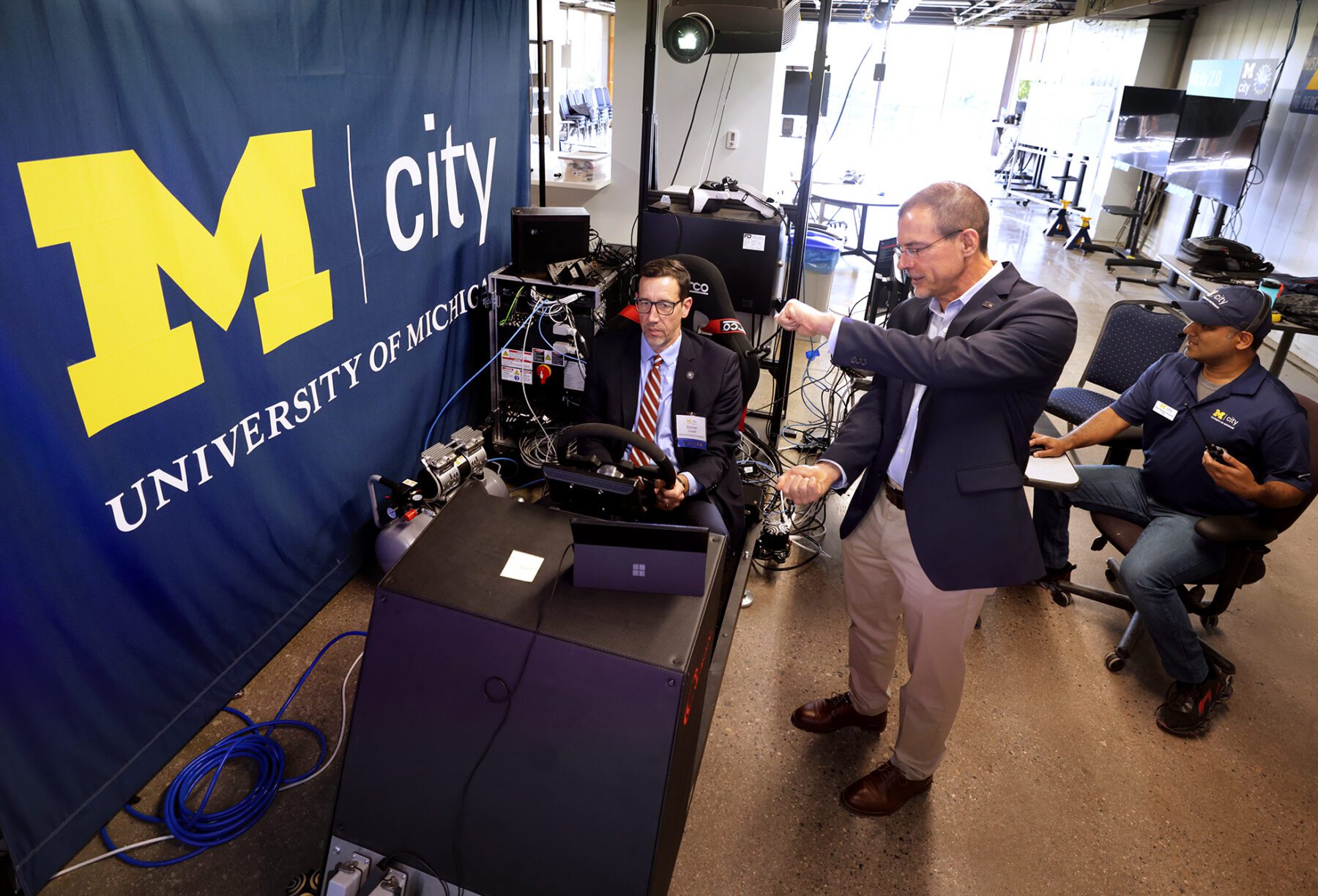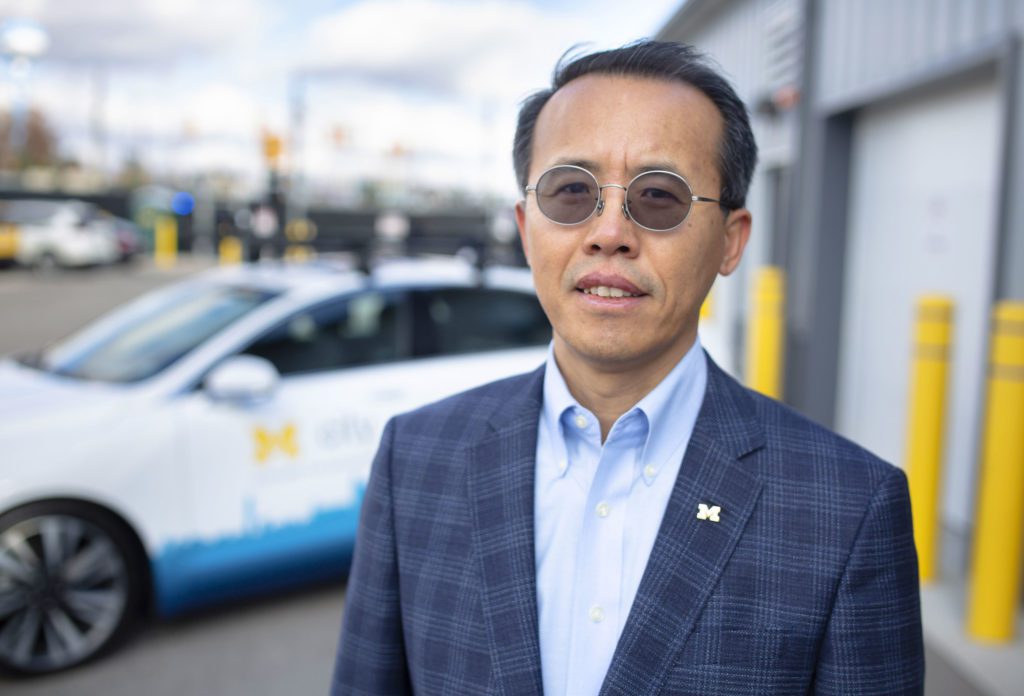Mcity opens for remote testing of autonomous vehicle technologies, calls for federal standards

From left, Daniel Linzell of the National Science Foundation sits in a driving simulator while Greg Stevens, Mcity research director, coaches him through remote teleoperation of an AV inside the Mcity Test Facility. Raj Patnaik, right, senior software engineer for Mcity, provides technical support.
Remote testing could accelerate adoption of AVs, but innovators need to know the safety regulations they must meet
As Mcity begins welcoming researchers in autonomous and connected vehicle technologies from around the U.S. to be remote users of its physical and virtual testing environment, its leadership is calling for federal standards for safety testing, arguing that the lack of clear goalposts is hampering development.
The opening also coincides with a new industry partnership project with MITRE and NVIDIA that was announced Oct. 8 at the NVIDIA AI Summit.
Following two years of upgrades, the University of Michigan’s hub for autonomous testing has officially kicked off its remote program with a series of demonstrations for industry and state and federal government officials. By allowing outside researchers to tap into Mcity research vehicles and testing technologies from afar, U-M seeks to accelerate the development of autonomous vehicle technologies to enable safer and more efficient transportation. Funded by the National Science Foundation, the capabilities are initially available to academic researchers.
“This is particularly valuable for academic institutions, including many that serve minority students, that do not have the resources of large, public institutions like U-M,” said Henry Liu, U-M professor of civil and environmental engineering and director of both Mcity and the Center for Connected and Automated Transportation. “We call it Mcity 2.0—the next-generation automated vehicle test facility.
“We believe Mcity 2.0’s capabilities will expand the volume and increase the speed of AV research that will be conducted and published. This could help put more refined, safer AVs on our roads sooner.”
At the same time, a new Mcity partnership announced at the NVIDIA AI Summit in Washington, D.C., aims to advance its remote testing capabilities for industry as well as academic users. Mcity simulation tools are being tapped for a new project in partnership with NVIDIA and nonprofit research managing firm MITRE. The goal is a full simulation version of Mcity that industry and academic researchers can use to rigorously test and validate AVs, accelerating their development and adoption.
“We believe Mcity 2.0’s capabilities will expand the volume and increase the speed of AV research that will be conducted and published. This could help put more refined, safer AVs on our roads sooner.”
–Mcity Director Henry Liu

An invitation to researchers across the U.S.
In the coming year, Mcity plans to assist 10 research teams from academic institutions in the U.S. with their testing needs. Researchers can submit proposals to Mcity.
By connecting to Mcity’s cloud-based digital infrastructure, researchers operating from their home bases can test their autonomous algorithms in virtual and mixed reality environments. Using 5G wireless communications, they can control physical vehicles and traffic signals on Mcity’s test streets, and receive real-time data in return—all while protecting proprietary information.
“We invite researchers from across the country to connect with us and join the effort to accelerate developing and deploying connected and autonomous vehicles that will make transportation safer, cleaner and more accessible,” said Karen Thole, the Robert J. Vlasic Dean of Engineering. “Please add your brain power to advancing tomorrow’s technologies.”
The critical role of federal regulation
Liu believes federal leadership—in the form of testing standards and funding—is crucial to accelerating development and rollout of AVs to achieve they benefits they could provide: safer roads, cleaner air, greater access to mobility options for those who have little or no access today. Several unanswered questions lie at the heart of the matter, including:
- How should AVs be tested and evaluated? How safe is safe enough?
- How do we properly prepare our infrastructure to support AV technologies?
- How should AVs be licensed?
- How should AVs be insured?
“Ensuring safety is important for consumers, for autonomous vehicle developers, for the federal government as well,” Liu said in an interview with the Associated Press that was published Oct. 8. “The federal government has the responsibility to help set the minimum standard, to help provide guidance in terms of safety testing.”
Mcity has developed a two-part methodology for evaluating AV safety, called the Mcity Safety Assessment Program. The first component tests driving algorithms’ basic competency in ordinary traffic scenarios. The second component challenges the software with a diverse set of dangerous driving scenarios—representing those that most often result in crashes, injuries and fatalities.
Opened in 2015, Mcity was the world’s first purpose built-proving ground for connected and automated vehicles. In 2022, a $5.1 million grant from the National Science Foundation helped U-M develop Mcity’s digital infrastructure—leading to Mcity 2.0.
This story was written by Jim Lynch of Michigan Engineering.